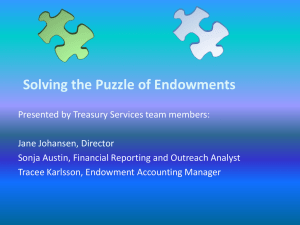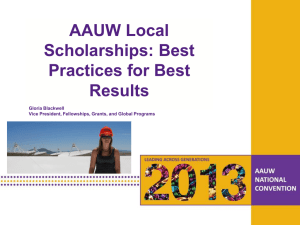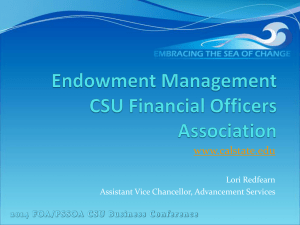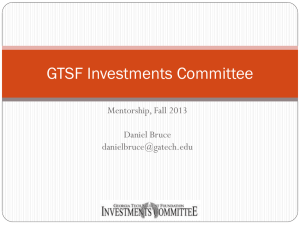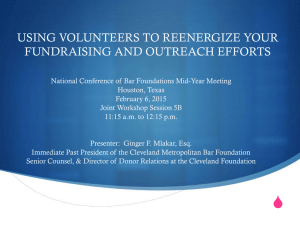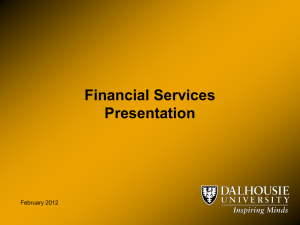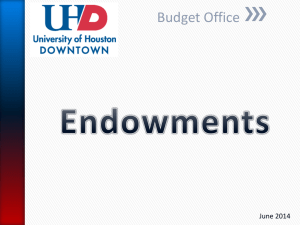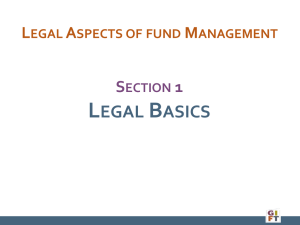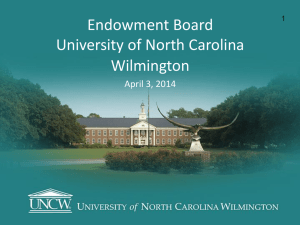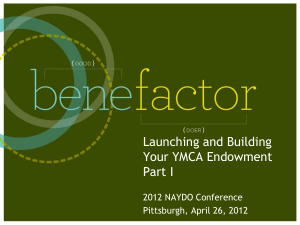Building a Monumental Endowment - Introit
advertisement
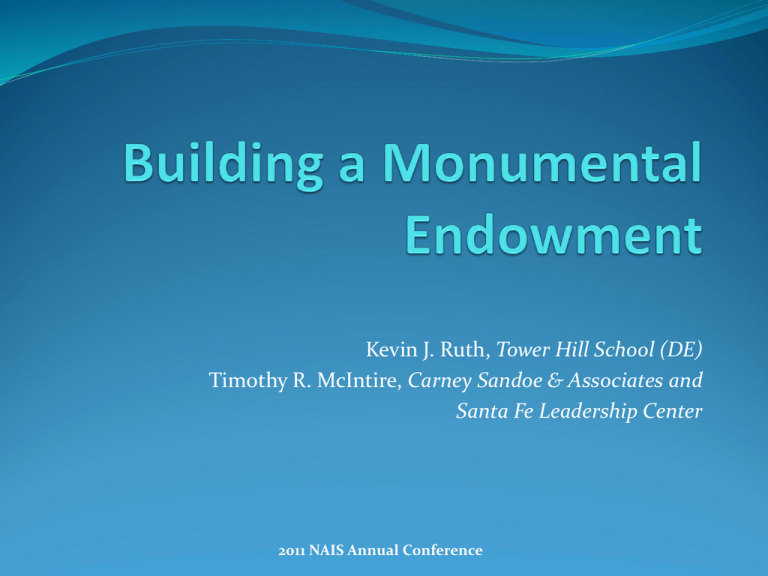
Kevin J. Ruth, Tower Hill School (DE) Timothy R. McIntire, Carney Sandoe & Associates and Santa Fe Leadership Center 2011 NAIS Annual Conference Overview Opening Remarks Fundamentals nomenclature purity governance Traditional Model for Endowment Growth Layered Model Layer One: “Long-Term” Layer Two: “AF Added” Layer Three: “CF Added” Layer Four: “TEP Added” Simulations Q&A Fundamentals (1) - Nomenclature Endowment ≠ Cash Reserves Do not confound the two terms Cash reserves = 100% liquid; different purpose An endowment portfolio may include cash as strategic component Fundamentals (1) – Nomenclature, continued PURPOSE OF ENDOWMENT “Intergenerational Equity” --James Tobin, “What is permanent endowment income?” American Economic Review 64.2 (1974) Three Types of Endowment Permanent (true) endowment Quasi-endowment (board-designated) Term endowment (restricted use for limited term) Fundamentals (1) – Purity and Governance A Note on Purity Suggestion: do not commingle other assets with your endowment Governance Endowment is the board’s business Establish separate Investment Committee and Gift Acceptance Committee May choose to work with external endowment manager May choose to work with large endowment management company Pay attention to minimum requirements Beware conflict of interest when managing funds (board members) Endowment spending policy Consult NACUBO (nacubo.org) for guidance on UPMIFA and FASB standards How do we grow an endowment? The Traditional Development Model (Small Shops) Annual Fund is main focus Gifts for restricted purposes Grant proposals What about endowment? “We have so many current needs…” “It’s difficult to raise money for endowment…” “Hopefully, someone will leave us a bequest…” The traditional model, by design, relegates endowment to the back-burner. Current needs are assigned as Priority 1, while future needs tend not to be assigned a Priority at all. ○INTERGENERATIONAL EQUITY○ ○INTENTIONALITY LEADS TO SUSTAINABILITY○ A Note on Sustainability of Small Endowments SAMPLE ACADEMY Endowment corpus: $1.5 million Annual inflow to endowment: $0 (but hoping for that mega-gift…) Average return: 6.0% Management fee: 0.5% Draw: ??? Let’s do some math… How much can you afford to draw from your endowment? (NACUBO-Commonfund 2010 Study: average was 4.5%) Remember to think like a trustee: intergenerational equity Answer(s)? What can we learn from that illustration? 1. 2. 3. 1. 2. 3. Intergenerational equity = paying attention to inflation Inflation = diminished returns Diminished returns = reduced draw capacity ERGO… Endowment inflows cannot = $0 Stagnant/no inflows = weak/no draw Weak/no draw = diminished impact on students and programs A BETTER ENDOWMENT GROWTH MODEL Promotes regular, sizeable inflows to endowment Allows for accurate forecasting of sustainable spending over time Provides a way to outpace inflation, benefitting students and programs Builds on and enhances the traditional model Utilizes a well-crafted endowment spending policy Monumental Endowment Growth Model • • • • • CAVEATS Must be in financial position to delay gratification Leadership at all levels must be committed to endowment growth Full alignment within school community School alignment with low time preference How’s your ego? Our Friend…Benjamin Franklin 1790 – Benjamin Franklin’s will spells out 1,000 Pounds each to the cities of Philadelphia and Boston (as well as to Commonwealth of Pennsylvania) Stipulation – money must be invested at 5% interest, and cannot be touched for 100 years; then withdraw ¾ and use for civic projects. Remaining ¼ is reinvested for another 100 years. 8th Wonder of the World – compound interest Result: hundreds of projects funded; trade school in Boston (Benjamin Franklin Institute of Technology); science and technology museum in Philadelphia (Franklin Institute); grants still being made GIFT – Global Investment Foundation for Tomorrow globalinvestmentfoundation.org Applying Franklin’s Model to Independent Schools 1 – Compound interest is our friend 2 – Term endowment is our friend 3 – Can be structured around existing endowment 4 – Takes courage, foresight, and stick-to-it management! How Do We Model It? Working Investment Allocation Asset Class U.S. Lg Cap Eq U.S. S/M Eq Int'l Eq Private Eq U.S. Core FI High Yield FI Real Estate Cash Allocation Min Target Max 0% 20% 80% 0% 20% 60% 0% 20% 40% 0% 0% 40% 0% 10% 80% 0% 10% 20% 0% 10% 40% 0% 10% 100% Typical Independent School Scenario Typical Scenario – The Long Term View Typical Scenario – What If We Didn’t Spend? Typical Scenario – Recap Before After $500K initial funds $500K initial funds Maintain $500K principal Maintain $500K principal 4.5% draw No draw 0.5% management fee 0.5% management fee 3.75% inflation 3.75% inflation 6.0% return on assets 6.0% return on assets RESULT Rapid depletion RESULT $17.4 million (Real dollars) We call the “typical scenario” LAYER ONE The Power of Layering Your Endowment Long-Term Layer One AF Added CF Added TEP Added Layer Two Layer Three Layer Four *Annual Fund *Class Funds *Traditional Endowment Program Layer Two – AF Added Layer Two - Recap Layer 1 Only Layers 1 and 2 $500K initial funds Same assumptions as Layer 1 Maintain $500K principal Added $25,000/year, growing No draw at inflation In other words: 10% of $250K Annual Fund, growing at inflation 0.5% management fee 3.75% inflation 6.0% return on assets RESULT $17.4 million RESULT $90.6 million Layer Three – CF Added (“Super 50” Funds) Layer Three is a medium-term endowment strategy Term endowment 50 years in length = “Super 50 Funds” or “Class Funds” Class Funds – each graduating class engages in philanthropic effort to raise $5,000, to be matched 1:1 by trustees, equaling $10K Development Office uses Class Fund to keep class in touch with school; in addition to Annual Fund gifts, office asks for gifts to Class Fund At every 5-year reunion, special solicitation for Class Fund and Annual Fund In 50 years’ time, class members will be retiring. They will be close to your school, thanks to the Class Fund effort over the years. Class votes how money should be deployed: restricted endowment or unrestricted endowment. Layer Three - Perspective Layer Three - Recap $10K initial funds (“Class of 2011” Fund) Maintain $10K principal $500/year recurring gifts from annual appeal to Class of 2011, over life of fund Reunion year gifts, starting at 10th Reunion, every 5 years; dollar amount equal to reunion year (i.e., 10th reunion = $10K; 40th = $40K) No draw 0.5% management fee 3.75% inflation 6.0% return on assets RESULT $388,000 Don’t forget: You’ll follow this formula for every class…it adds up! You will see the result of “Layer 3: CF Added” in a few minutes Layer Four – Traditional Endowment Program (TEP) TEP = meeting current needs through current endowment spending In many schools, TEP looks something like this: We have a modest endowment We are spending circa 5.0% per annum We sometimes receive bequests, or a family starts a scholarship fund Development office is a small shop = focus on Annual Fund and grants How can we grow our endowment sooner rather than (in addition to!) later? Layer Four: Simple Steps to “Sooner” 1. 2. 3. 4. 5. 6. Stop drawing 5% per annum. You can’t afford it. Be realistic. You won’t grow a mega-endowment in three years! Use your strength: designate 10% of unrestricted Annual Fund gifts to unrestricted endowment Institute a minimal planned giving program that focuses on bequests only. Identify and close 25 people in five years; start with the current and past Board. Plan and launch an endowment campaign that serves to heighten the community’s awareness of the importance of endowment. Highlight your long-term endowment strategy, but also highlight need for current endowment dollars. Planned gifts are encouraged! Don’t forget that your “Super 50” Class Fund gifts begin to arrive at 50 year mark! Layer Four – First Scenario Layer Four – First Scenario - Stats Model: Assumptions Corpus: $1.5 million Maintain principal 4.5% annual draw 3.75% inflation 6.0% return on investments 0.5% management fee Model: Inflows to Endowment $25K from Annual Fund (10%), adjusted for inflation Planned Gifts: starting in tenth year (2020), $25K in PG every five years, adjusted for inflation Endowment Campaign: raise $1.5 million in year five (2015) Class Funds enter in 2060 RESULTS --You lose money for first three years! --Ending corpus: $31.2 million Layer Four – Second Scenario at 3.0% Draw RESULT: $50.3 million Four Layers – In Full Concert $49 MM @ 6/30/2108, but $129 MM @ 6/30/2109 Closing Thoughts Layered endowment strategy is effective Low time-preference is key Concerted, focused, long-term effort Model allows for multiple variables: adjust the draw long-term endowment fund: take 1/3 at 25 years, 1/2 at 50 years make class funds shorter (target the 25th reunion) ramp up development efforts: AF, PG, MG Q&A Presentation found at introit.typepad.com
